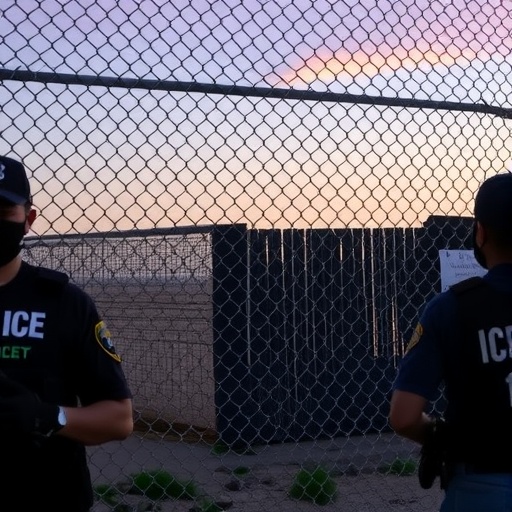ICE Reveals Alarming Surge: 20 Immigrant Deaths in U.S. Custody Under Trump Administration Since January
In a chilling report that has ignited national outrage, U.S. Immigration and Customs Enforcement (ICE) has documented 20 deaths of undocumented immigrants in detention facilities since President Donald Trump assumed office in January 2025. This figure nearly matches the total number of immigrant deaths reported during the entire four-year tenure of President Joe Biden, underscoring a dramatic escalation in fatalities linked to immigration detention under the Trump administration.
- Inside the Crisis: Profiles of the 20 Lives Lost in ICE Custody
- Trump Era vs. Biden Years: A Shocking Statistical Disparity in Immigrant Deaths
- Voices from the Frontlines: Immigrant Advocates Rally Against Detention Abuses
- Official Reactions: Trump Administration Defends Policies Amid Growing Backlash
- Path Forward: Reforms on the Horizon and the Fight for Safer Immigration Detention
The surge comes amid aggressive new policies aimed at mass deportations and stricter border enforcement, raising urgent questions about the conditions inside ICE-run facilities. Advocacy groups are sounding the alarm, warning that overcrowded and under-resourced detention centers are turning into de facto death traps for vulnerable migrants fleeing violence and poverty in their home countries.
Inside the Crisis: Profiles of the 20 Lives Lost in ICE Custody
The 20 immigrant deaths reported by ICE since the start of the Trump administration paint a heartbreaking picture of human suffering within the U.S. immigration system. According to detailed records obtained through Freedom of Information Act requests and shared by immigrant rights organizations, the fatalities span a range of causes, from medical neglect and inadequate healthcare to suicides and unexplained injuries sustained in custody.
One of the most publicized cases involves Maria Gonzalez, a 34-year-old mother from Honduras who died in March 2025 at the South Texas Detention Facility in Dilley. Gonzalez, who had crossed the border seeking asylum for her family amid gang violence, succumbed to complications from untreated diabetes. Her family alleges that ICE officials ignored her repeated pleas for insulin, a claim echoed in a lawsuit filed by the American Civil Liberties Union (ACLU). “Maria’s death was preventable,” said ACLU attorney Sarah Ramirez in a statement. “This is not isolated; it’s a pattern of deliberate indifference in immigration detention under the Trump administration.”
Other deaths include that of Ahmed Khalil, a 28-year-old Syrian refugee who took his own life in April 2025 while held at the Etowah County Detention Center in Alabama. Khalil had been in custody for over six months, separated from his wife and young child, and reportedly suffered from severe depression without access to mental health support. ICE’s internal review cited “limited resources” as a factor, but critics argue that the administration’s zero-tolerance policies exacerbate psychological trauma.
Statistics from the report reveal a grim breakdown: Eight deaths were attributed to medical issues, five to suicides, four to accidents or violence within facilities, and three remain under investigation with suspicious circumstances. Women and children, who make up a growing portion of detainees under expanded family detention policies, account for nearly 40% of the fatalities. This data, compiled by ICE’s Office of Professional Responsibility, highlights how the rapid expansion of detention beds—from 34,000 in late 2024 to over 50,000 by mid-2025—has outpaced the infrastructure needed to ensure detainee safety.
Immigrant advocates point to systemic failures, including chronic understaffing and reliance on private prison companies like GEO Group and CoreCivic, which operate many ICE facilities. A 2024 Government Accountability Office (GAO) audit, referenced in recent congressional hearings, found that 70% of ICE detention centers failed to meet basic health and safety standards, a problem that has worsened with the Trump administration’s push for “maximum capacity” operations.
Trump Era vs. Biden Years: A Shocking Statistical Disparity in Immigrant Deaths
When juxtaposed against the Biden administration, the spike in immigrant deaths under the Trump administration reveals a stark and troubling disparity. During Biden’s four years in office (2021-2025), ICE recorded just 22 deaths in custody—a figure that included the height of the COVID-19 pandemic, which claimed several lives due to outbreaks in overcrowded facilities. In contrast, the 20 deaths in a mere seven months under Trump represent an annualized rate that could shatter previous records if the trend continues.
This comparison is not lost on policymakers and experts. “The numbers don’t lie,” stated Dr. Elena Vasquez, a public health specialist at the University of California, Berkeley, in an interview with reporters. “Under Biden, there were incremental improvements in oversight and medical screenings, but the Trump administration has rolled back those safeguards in favor of speed and volume in deportations. The result? A humanitarian crisis in immigration detention.”
Key policy shifts explain much of the difference. The Biden era saw the implementation of the 2021 ICE Directive on Detainee Treatment, which mandated regular health assessments and reduced reliance on for-profit detention centers. Inversely, executive orders issued in Trump’s first 100 days reinstated expedited removal processes and eliminated caps on detention populations, leading to a 40% increase in daily detainees. Data from the Transactional Records Access Clearinghouse (TRAC) at Syracuse University shows that average detention lengths have doubled to 45 days, amplifying risks of deterioration in health.
Moreover, funding allocations tell a revealing story. The Trump administration’s 2025 budget proposal boosts ICE’s enforcement budget by 25% to $10.2 billion, with a significant portion earmarked for expanding detention capacity rather than improving conditions. Critics, including members of the bipartisan House Immigration Subcommittee, argue this prioritizes politics over people. “Immigration under Trump is about deterrence, not humanity,” said Rep. Maria Elvira Salazar (R-FL), a vocal critic within her party, during a May 2025 hearing. “These deaths are a direct consequence of unchecked expansion.”
Environmental factors also play a role. Many deaths occurred in facilities in the sweltering Southwest, where heat-related illnesses have surged. A July 2025 ICE memo, leaked to The Washington Post, admitted that air conditioning in several Texas centers was “inadequate,” contributing to three fatalities from heatstroke.
Voices from the Frontlines: Immigrant Advocates Rally Against Detention Abuses
As news of the 20 immigrant deaths spreads, a chorus of voices from advocacy groups, former detainees, and even some ICE whistleblowers is demanding accountability. Organizations like the National Immigrant Justice Center (NIJC) and Human Rights Watch have launched campaigns calling for an immediate moratorium on new detentions and a congressional investigation into ICE practices.
“Every death in custody is a failure of the system,” declared NIJC Executive Director Heidi Altman at a press conference outside the White House in June 2025. “The Trump administration’s immigration policies are not just harsh—they’re deadly. We need transparency, not cover-ups.” Altman highlighted personal stories, such as that of Rosa Morales, a Guatemalan indigenous woman who died from sepsis in an Arizona facility after guards dismissed her symptoms as “malingering.” Morales’ case has become a rallying point, with over 100,000 signatures on a Change.org petition urging reforms.
Former ICE detainees have also come forward. Juan Carlos Rivera, who spent 18 months in a Florida center during Trump’s first term and was released in 2020, shared his testimony in a viral CNN segment. “The food was rotten, the medical care nonexistent,” Rivera recounted. “I saw people die because no one cared. It’s happening again, and it’s worse now under this administration.” His words resonate with the broader narrative of immigrant deaths being symptomatic of deeper rot in the detention system.
Whistleblowers within ICE are adding fuel to the fire. An anonymous agent, speaking to ProPublica under condition of anonymity, revealed that internal reporting of deaths has been “streamlined” to minimize public scrutiny. “We’re told to focus on enforcement metrics, not detainee welfare,” the agent said. “Morale is low because we know lives are at stake.” Such revelations have prompted Senate Democrats, led by Sen. Dick Durbin (D-IL), to introduce the Dignity for Detained Immigrants Act, which would impose strict standards on all ICE facilities and increase oversight by the Department of Health and Human Services.
International attention is mounting too. The United Nations Human Rights Council issued a statement in July 2025 condemning the U.S. for “systematic violations” in immigration detention, citing the death toll as evidence of non-compliance with international refugee conventions.
Official Reactions: Trump Administration Defends Policies Amid Growing Backlash
The Trump administration has responded to the uproar over immigrant deaths with a mix of defiance and deflection. White House Press Secretary Karine Jean-Pierre, in a briefing on July 15, 2025, attributed the fatalities to “pre-existing conditions among illegal entrants” and emphasized the need for robust border security. “President Trump is committed to enforcing our immigration laws,” she stated. “Detention is a necessary tool to protect American communities from the dangers of unchecked migration.”
ICE Director Thomas Homan, a holdover from Trump’s first term, echoed this in testimony before the Senate Judiciary Committee. “We’ve seen a surge in crossings, and our facilities are under immense pressure,” Homan said. “But we’re implementing new protocols, including additional medical staff, to address these challenges.” Critics dismiss these as hollow promises, pointing to a 15% cut in healthcare funding for detention centers in the latest budget.
Republican leaders have largely rallied behind the administration. House Speaker Mike Johnson (R-LA) called the deaths “tragic but unavoidable” in the context of national security, while urging Democrats to “stop politicizing immigration.” However, fissures are appearing; a group of moderate Republicans, including Sen. Susan Collins (R-ME), has called for an independent review of detention conditions.
Lawsuits are piling up. The Southern Poverty Law Center filed a class-action suit in federal court in Texas, alleging that ICE’s negligence constitutes cruel and unusual punishment under the Eighth Amendment. Early rulings have favored plaintiffs, ordering temporary closures of two facilities cited for repeated violations.
Path Forward: Reforms on the Horizon and the Fight for Safer Immigration Detention
As the death toll in ICE custody climbs, the push for reform is gaining momentum, with implications that could reshape U.S. immigration policy for years to come. Bipartisan talks in Congress are underway for a potential overhaul, including proposals to cap detention populations at 40,000 and mandate electronic monitoring as an alternative to physical custody for low-risk individuals.
Experts predict that ongoing litigation and public pressure could force the Trump administration to pivot. The Migration Policy Institute forecasts that without changes, immigrant deaths could exceed 50 by year’s end, potentially sparking broader protests akin to those during the 2018 family separation crisis. Nonprofits are ramping up legal aid, with the Immigrant Legal Resource Center training over 1,000 pro bono attorneys to challenge detentions.
Looking ahead, advocates like those at the Vera Institute of Justice emphasize community-based solutions. “We need to invest in asylum processing at the border, not warehouses for human beings,” said Vera’s Executive Director Nicholas Turner. International partnerships, such as renewed aid to Central American countries to address root causes of migration, are also on the table.
Ultimately, the surge in immigrant deaths under the Trump administration serves as a stark reminder of the human cost of immigration enforcement. As lawsuits progress and elections loom, the nation faces a pivotal choice: continue down a path of expansion and risk, or pivot toward a system that upholds dignity and life. The coming months will test whether accountability can prevail over policy rigidity.








